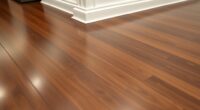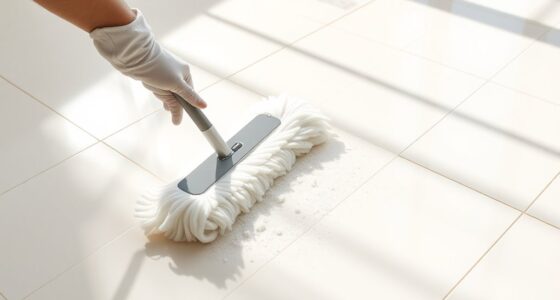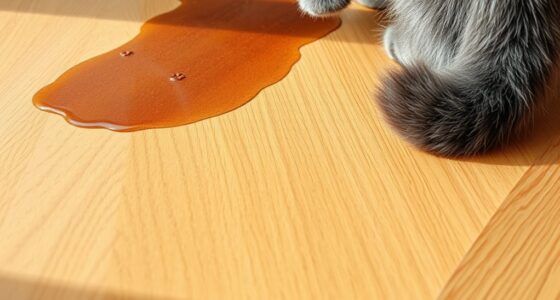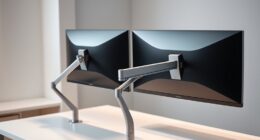To prevent squeegee streaks and lines, use a high-quality, streak-free glass cleaner and guarantee even coverage across the entire surface. Hold the squeegee at about a 30-degree angle and pull with steady, smooth motions from top to bottom. Keep the rubber blade clean and check for damage regularly. Proper technique and equipment maintenance make a big difference. Keep exploring ways to perfect your squeegee skills for spotless results.
Key Takeaways
- Use a high-quality, streak-free cleaning solution and ensure even coverage on the glass surface.
- Hold the squeegee at a consistent 30-degree angle and use smooth, continuous pulls from top to bottom.
- Regularly clean and inspect the squeegee blade to remove dirt, debris, and replace if worn or nicked.
- Wipe the blade with a microfiber cloth during use to prevent dirt buildup and streak formation.
- Avoid pressing too hard; apply steady, gentle pressure to prevent streaks and water marks.
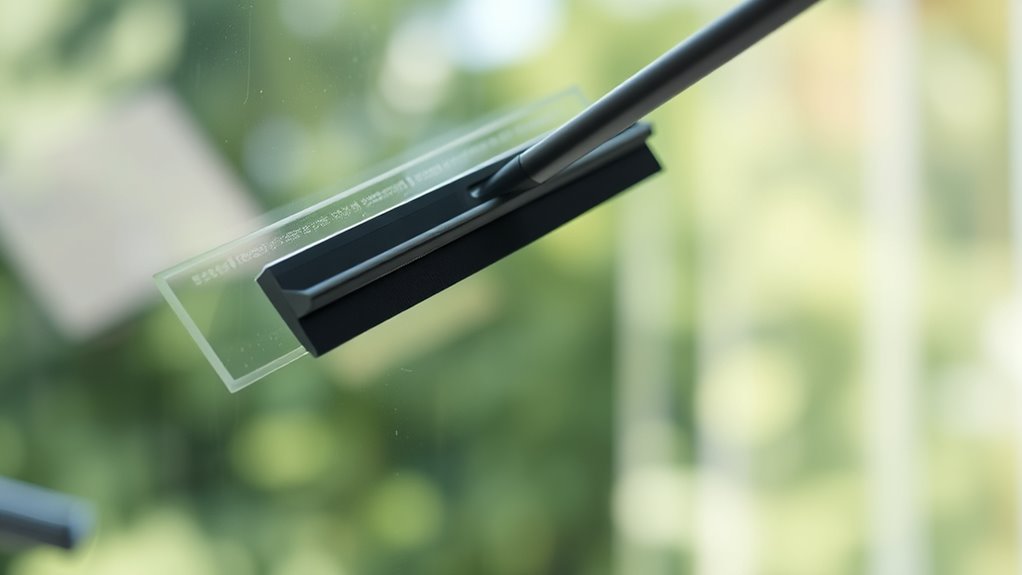
Squeegee streaks and lines can be frustrating, but with the right techniques, you can achieve a spotless, streak-free finish every time. The key starts with selecting the proper cleaning solution. Use a high-quality, streak-free glass cleaner or a mixture of water and a small amount of dish soap. Avoid harsh chemicals that can leave residue or cause streaks. Before you start squeegeeing, make sure your cleaning solution effectively loosens dirt and grime, allowing the squeegee to glide smoothly across the surface. Properly diluted solutions help prevent soap buildup, which can contribute to streaking. Always spray the cleaning solution evenly over the entire surface, ensuring no spots are missed. This creates a consistent layer that allows the squeegee to do its job more efficiently.
Choose a streak-free cleaner and spray evenly for spotless window cleaning.
Next, focus on your squeegee technique. Hold the squeegee at a slight angle—around 30 degrees—so the rubber blade makes continuous contact with the glass. Start at the top corner and pull downward with steady, even pressure. Avoid pressing too hard, as this can cause streaks or leave behind water marks. Use a smooth, continuous motion, and don’t stop mid-way across the glass; this helps prevent drips and uneven cleaning. When you reach the bottom, wipe the blade with a clean, lint-free cloth or sponge to remove excess dirt and water. This prevents dirt buildup on the rubber, which can transfer streaks back onto the glass.
Another critical aspect is the squeegee’s rubber blade. Always check for tears, nicks, or dirt on the blade before starting. A worn or dirty blade won’t provide a clean wipe and is more likely to leave streaks. Replace the blade if it’s damaged or excessively dirty. Also, ensure the blade makes full contact with the glass surface. If it’s loose or warped, it won’t wipe evenly, resulting in lines. Maintaining proper blade tension and replacing worn blades regularly can make a notable difference in achieving streak-free results.
Finally, clean your squeegee frequently during use. Rinse or wipe the rubber blade after each pass to remove dirt and prevent smudging. Use a microfiber cloth or sponge to wipe down the blade regularly, especially if you notice streaks forming. Additionally, maintaining the correct contrast ratio of your cleaning environment can help you see streaks more clearly during the process, ensuring a thorough finish. By combining the right cleaning solution with a consistent, careful squeegee technique, you’ll considerably reduce streaks and lines, leaving your windows crystal clear every time.
Frequently Asked Questions
Can the Type of Squeegee Affect Streak Formation?
Yes, the type of squeegee can influence streak formation. You should choose a squeegee with high-quality squeegee material, like rubber or silicone, for a smooth, even wipe. Also, consider handle design; an ergonomic handle helps maintain consistent pressure and control, reducing streaks. A well-made squeegee ensures you can clean efficiently and streak-free, making your work easier and results clearer.
Does Weather Influence Streaks When Cleaning Windows?
Yes, weather influences streaks when cleaning windows. High humidity can cause cleaning solutions to dry too slowly, leaving streaks behind, while low humidity helps solutions evaporate evenly. Temperature considerations also matter; cleaning in extreme heat can cause rapid drying and streaking, while cooler temperatures allow for smoother results. To prevent streaks, aim for moderate humidity and temperature, and choose ideal weather conditions for cleaning.
Are There Specific Cleaning Solutions That Reduce Streaks?
Yes, using eco-friendly solutions like vinegar and water or commercial streak-free cleaners can help reduce streaks. Pair these with microfiber cloths, which are excellent at picking up dirt without leaving lint or residue. When you apply your cleaning solution with a microfiber cloth, you’ll notice a smoother, streak-free finish. This method not only minimizes lines but also promotes environmentally friendly cleaning habits that are safe for your home.
How Often Should Squeegees Be Replaced for Optimal Results?
Ever wonder when your squeegee loses its edge? For peak results, you should replace your squeegee every 6 to 12 months, depending on usage and wear. Regular squeegee maintenance helps you identify signs of deterioration early. Streaks and lines often indicate it’s time for a replacement. Following a consistent replacement schedule ensures smooth, streak-free cleaning, saving you time and effort while keeping your windows crystal clear.
Do Different Glass Types Require Different Squeegee Techniques?
Yes, different glass types require different squeegee techniques to guarantee safety and effective cleaning. For instance, safety glass or tinted windows may need gentler pressure to prevent damage, and you should consider squeegee ergonomics to reduce strain during prolonged use. Adjust your approach based on glass thickness and surface smoothness, always prioritizing glass safety. Using the right technique helps avoid streaks, lines, and potential glass damage.
Conclusion
Just like a painter steps back to see the full picture, take a moment to inspect your work as you go. I once watched a friend struggle with streaks until she realized small, consistent strokes made all the difference. Remember, patience and attention to detail turn a messy job into a professional finish. With these tips, you’ll master the art of streak-free cleaning—making your windows sparkle as if they’re shining with fresh clarity.

